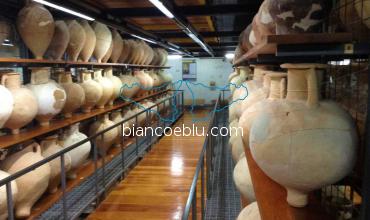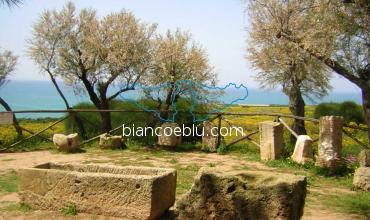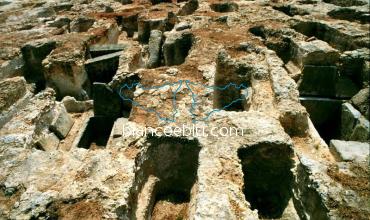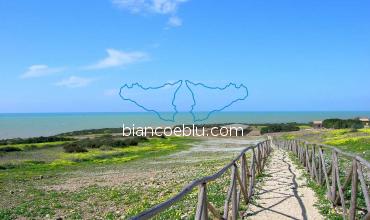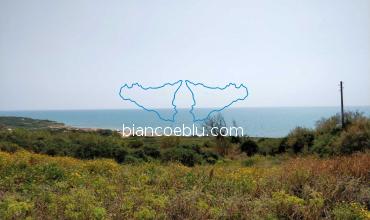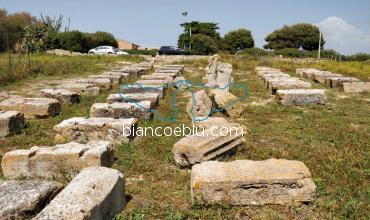Some Historical facts
Founded by the Greeks of Syracuse, the city of Kamarina was built in the 6th century BC on a hill by the sea. The place still preserves its ancient and wild charm. The winds, the sea, and the vegetation seem to take their guests back to when the fate of men was ruled by Gods. The remains of the city, strategically built along the African route, are still present and can be visited in the archaeological park of Kamarina. Inside the archaeological area, there is also the Archaeological Museum hiding within its walls priceless treasures that talk about the history, life, and death of the people who lived once in this city. It seems, from what emerges from various documents, that the city rose against the Syracusans.
.
Like many other places of the island's hinterland, here too the Sicilians did not appreciate the Greek-Syracusan hegemony. At the end of the numerous clashes, Syracuse won, but in the 5th century, the city was handed over to Hippocrates, the tyrant of Gela, to avoid a war with the Arethusa city.
Like many other places of the island's hinterland, here too the Sicilians did not appreciate the Greek-Syracusan hegemony. At the end of the numerous clashes, Syracuse won, but in the 5th century, the city was handed over to Hippocrates, the tyrant of Gela, to avoid a war with the Arethusa city.
The meaning of the name Kamarina is "inhabited after much effort" and never has the name been so significant, as it was destroyed and rebuilt several times. Both the Carthaginians in 339 BC. C. that the Romans in 258 BC and again the Arabs in 827 AD. destroyed it and rebuilt the city that stands on the Kamarina hill and near the origin of the Ippari river.
Kamarina's Archeological Area
Even though the remains of the buildings are patchy, this archaeological area is among those worthy to see in Sicily. The archaeological heritage that the Kamarina’s territory has given to the world is immeasurable both that found on land and that found in the sea. Today these remains are evidence of the vastness of the territory and the importance that the city also had as a port overlooking the Mediterranean.
In the stretch of the very origin of the Ippari River, can still be seen the traces of what was once a very busy port. The necropolis excavations also involved the Passo Marinaro village and the Rifriscolaro district. All the artifacts found on the site have given the possibility of reconstructing the ancient city as it was between the 4th and 5th centuries BC. Certainly, what emerged from the reconstruction is that Kamarina was one of the most beautiful cities of its period in Sicily, from an architectural point of view.
In the archaeological park, the few remains of the temple of Athena are situated at the highest point of the hill, and the acropolis is still clearly visible. In the agora place where the vibrant economic-political life reigned, the excavations have not been finished. The remains are fragmentary, the most conspicuous part of the finds discovered concerns the walls defending the city which was located under the hill where the temple of Heracles is hypothesized.
From the excavations carried out were found the tombs of the necropolis dating back to the period from the 5th century to the time of Roman domination, which was around 258 BC. The finds from the Kamarina excavations are kept in the archaeological museums of Kamarina, Ragusa, and Syracuse.
The archeological artifacts inside of the museum
The building that hosts the Archaeological Museum of Kamarina is a late 19th-century farmhouse, with a typical structure of the Hyblaean coastal area, built around the remains of the temple of Athena. Outside of this building, there are the remains of the temple. There are many pieces discovered during the excavations and exhibited outside the museum: sarcophagi, column parts, stone epigraphs, and anchors. The finds kept in the park museum are of great archaeological importance and outline the rich economic, commercial, and social life of the ancient city.
The museum halls leave an important section to underwater finds, a pure treasure of the national level. The wrecks found near the coast between Scoglitti and Caucana make it clear how ships route in that stretch of sea, often severely beaten by Southern wind gusts leading to shipwrecks. There are numerous shipwrecks found in this part of the Mediterranean.
Among the objects kept in the museum, there are coins and artifacts of bronze, as well as an intact glass vase, evidence of a prosperous commercial world. It is assumed that the ships making those routes could have been in transit to Greece, the Nile Delta, Rome, or Asia Minor. Also of notable importance is the discovery of a wreck with a monumental load, composed of two columns in ancient yellow marble from Numidia intended to decorate some patrician villa.
The Kamarina Archaeological Museum is divided into 5 sections, and all its rooms provide information on the finds that introduce to the visitors the objects present inside the room.
- Pavilion of underwater finds
- Pavilion of archaic amphorae
- East pavilion with 4 exhibition rooms
- West Pavilion.
- Underwater pavilion of Kamarina Museum
Entering the museum is the underwater pavilion that at the very beginning surprises its guests with the artifacts found in the Mediterranean waters. Transport amphorae, a Corinthian helmet, an Attic-Etruscan helmet, the statuette of Aphrodite, and the god Harpocrates. And again, the 5000 bronze coins and the marble columns are just some of the treasures of this pavilion.
Pavilion of archaic amphorae
One has to go out into the courtyard to reach this pavilion, located between the rooms of the farm's cellar and the first floor, where the amphorae are the undiscussable protagonists. These are discoveries made in the necropolis of the archaic period found in the Rifriscolaro district and the classical period necropolis of the Passo Marinaro district, two areas surrounding Kamarina.
.
.
Many of the amphorae had been used for burials and held the bodies of infants. These amphorae are more than 1000, and they were primarily used for the transport of food from Corinthian, Attic, Punic, Greek, and Etruscan production, and many others, still unidentified. In addition to their funerary use, the amphorae are witnesses of the flourishing commercial world that affected the ancient city, since in their original function they were intended for the transport of wine and oil.
East pavilion
there are 4 exhibition rooms in the east pavilion:
- Prehistory Hall: The findings of this room are dated back to the Bronze Age. In addition to them, together with documents that attest to the presence of populations in the territory, there are also tools and artifacts, as well as fossil remains of animals found in the Kamarina’s territory.
- Archaic Kamarina Hall: In this room, you can see the finds that belong to the first settlements, as well as the discoveries made in the necropolis of the Rifriscolaro district with the related funerary objects.
- Persephone Hall: This room pays honor to the goddess Persephone whose rites, inherent to her cult, were very important for the city from a religious point of view, both during the Greek and Roman domination. She was the wife of Hades, the queen of the underworld. There are many artifacts found on site, such as statuettes and decorative elements.
- Hall of the Temple of Athena: In this room, you can look closer at what has remained of the temple of Athena. Various parts of the original structure, such as the base of the temple dedicated to the goddess of Wisdom, are kept here. Furthermore, there are also various terracotta artifacts and a scale reconstruction of the temple in this room.
West Pavilion
In the west pavilion, there are 2 exhibition rooms:
- Classical Kamarina Hall: In this area of the pavilion it is possible to get an idea of what the city might have been like from an urban planning point of view in the classical age, in the 5th century BC. C., with the related finds.
- Necropolis room of Passo Marinaro: On this site, there are the finds of the funerary objects of the classical necropolis found in Passo Marinaro. Among the objects of the time, found during the excavations, you can admire bell-shaped craters with red prints on a black background, bowls, cups, and many other Attic-style ceramic artifacts.
Library
In the library of the Archaeological Museum of Kamarina, it is possible to make your research due to the 500 volumes of various Italian and foreign publications in the field of archaeological history.
Going digital
In August 2021 was signed an agreement for the free international disclosure of the archaeological site of Kamarina, with all the artifacts kept there. It was signed by the Superintendency of Cultural Heritage of Ragusa, the Archaeological Park of Kamarina, and Global Digital Heritage. Every single find that has been brought to light on the site, now kept in the museums of Ragusa and Kamarina, will be scanned in 3D and will subsequently be available online due to this agreement. This project aims to make the historical-archaeological heritage of this part of Sicily known throughout the world.
How to reach the museum
The Kamarina Regional Museum is located on the S.P. 102 of Ragusa, at about km. 1.5 distance of communes of Santa Croce Camerina and Scoglitti.
For information on timetables and ticket costs visit the site: https://www.beniculturali.it/luogo/museo-regionale-di-kamarina - Tel. +39 3346040449.
